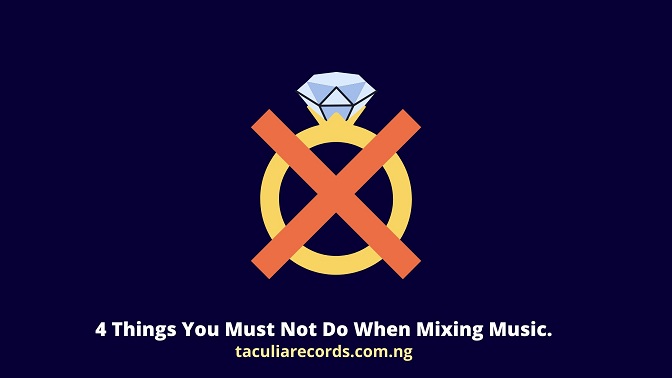As you are beginning your journey into recording and mixing music, whether it’s your own music or you are mixing for others, everything might just seem so easy, especially when everything goes right for you.
However, in this digital recording age where we have plugins and presets built in, it often seems so tempting to keep playing around long after your mixing is perfect.
Unfortunately, it is certainly possible to reach a point where you are hurting the overall clarity of your mix.
Fortunately for you, these bad mixing habits are very easy to avoid, so let’s look at the 4 things you must not do when mixing music.
4 Things You Must Not Do When Mixing Music.
The 4 things you must not do when mixing music are
- Don’t mess with plugins.
- Never forget to watch your sample rate.
- Never always forget to save your work frequently.
- Don’t use low-quality monitoring.
1. Don’t mess with plugins.
We’ve all at one time or another fall victim to messing around with plugins while mixing our music or for others.
Imagine playing around with the newest effect, and all of a sudden, your perfect mix begins to sound muddy, less defined, and over-saturated with effects.
That is always not good at all. Therefore, always know when to stop using effects or plugins when mixing music.
Once your mix sounds perfect to you or your client’s ears, STOP MIXING, and save a copy of the session.
If you, however, wish to experiment, you can open a new copy of the session apart from the perfect one, and experiment away – but make sure you saved a copy of the perfect mix.
2. Never forget to watch your sample rate.
I once made a huge mistake while tracking a live concert of a wedding event because my sample rate on my interface was slaved to a piece of outboard equipment at 48KHZ, while the digital feed I was getting was 44.1 KHZ.
The result was that despite recording at what I thought was right, all my recordings sounded slowed down when I listened to them.
Resampling didn’t help in any way, so I eventually had to delete the recording and use a DAT backup, as I couldn’t get the sample rate corrected well enough.
So, therefore, you must always watch your input settings and make sure your settings are all on the same page between your various pieces of equipment.
It is very hard to always correct this kind of mistake afterward unless you are very skilled in post-production as well as have unlimited patience which I do not.
3. Never always forget to save your work frequently.
The laptop I use for recording has an embarrassing problem in that anytime I am in battery mode I have like 40 minutes after it’s fully charged before it completely dies out.
It doesn’t even enter sleep mode, it simply dies off around 20 minutes left on the battery meter.
And for this reason, during any recent recording session, I had the perfect kick sound going, and all of a sudden my laptop died off because I didn’t realize that the charger had slipped out.
Needless to say, I was very upset with myself because I did not save my work.
With Protools and several other programs, you can set your session to automatically save your work at intervals you chose. This is very wise as you will never miss an opportunity to save on a good junction again.
4. Don’t use low-quality monitoring.
Using low-quality monitoring or headphones to mix will never give you an accurate picture of what you are doing with a mix.
And when you get your mix done (or so you think), and you or anyone else listen on a CD player, iPod, or car stereo it sounds muddy and undefined.
So never skimp on your monitoring setup. Whether you chose to go with headphones, in-ear style monitors, or traditional speakers, make sure you settle for a great quality setup at the high end of what you are able to afford.
There are a lot of great options out there for those who are on a budget that will never skimp on quality.

